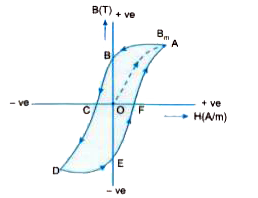Explain the phenomenon of hysteresis in magnetic materials.
A complete cycle of magnetisation [i.e, graph between magnetisation M (or total magnetic field B developed in the sample) of the sample and magnetising intensity H] for a given ferromagnetic material (say steel) is being shown in Fig. The curve obtained is called hysteresis curve. From this graph, we draw following conclusions:
(i) Initially as →H is raised from its zero value →B also rises from zero toa s saturation value →Bm and it is being represented by the curve. OA . But the curve OA does not retrace itself as →H is reduced . →Bm is called "magnetic saturation" of the given sample .
(iii) As →H is reduced, the curve is along AB. Point B indicates the value of magnetic field B left behind even when →H is reduced to zero. This value of field →B , (given by OB) is called .residual magnetism. or .retentivity. or .remanence..

(iii) To reduce →B to zero we have to increase value of →H in the reverse direction. In figure point C represents the state of →B =0 . Value of →H corresponding to point C i.e. →HC is known as .coercive force. or .coercivity..
(iv) No segment OA, AB, BC, CD ... etc., of the curve is linear. It means that →B is not directly proportional to →H over any appreciable range.
(v) Lagging behind of →B as compared as →H is known as the .Hysteresis. and the magnetisation cycle curve is known as the hysteresis curve.
(iv) The area within the B-H loop represents the energy dissipated per unit volume per cycle in the material.
Related Playlists
- BOOK - U-LIKE SERIESCHAPTER - MAGNETISM AND MATTEREXERCISE - LONG ANSWER QUESTIONS-II2videos
MAGNETISM AND MATTER
- BOOK - U-LIKE SERIESCHAPTER - MAGNETISM AND MATTEREXERCISE - SELF ASSESSMENT TEST (Section A) (Multiple choice Questions)5videos
MAGNETISM AND MATTER
- BOOK - U-LIKE SERIESCHAPTER - MAGNETISM AND MATTEREXERCISE - SHORT ANSWER QUESTIONS22videos
MAGNETISM AND MATTER
- BOOK - U-LIKE SERIESCHAPTER - EXAMINATION PAPER 2020 (SOLVED)EXERCISE - SECTION D6videos
EXAMINATION PAPER 2020 (SOLVED)
- BOOK - U-LIKE SERIESCHAPTER - MODEL TEST PAPER 1 (UNSOLVED)EXERCISE - SECTION B1videos
MODEL TEST PAPER 1 (UNSOLVED)
Similar Questions
Explain the phenomenon of osmosis.
View SolutionExplain the phenomenon of viscosity in detail.
View SolutionExplain the phenomenon of global warming.
View SolutionPhenomenon of diffraction occurs
View SolutionThe phenomenon of electro-magnetic induction is
View SolutionThe phenomenon of electro-magnetic induction is
View SolutionExplain the term hysteresis.
View SolutionEmerson effects explain the phenomenon of
View SolutionTable 29.10 gives the coordinates of some of the points of the asymptotic hysteresis cycle of a ferromagnetic material. Plot the hysteresis loop. (The recommended scale is 10 mm = 100 A/m and 10 mm 0.20 T.) Find the coercive
 force and saturation induction from the graph. Calculate the saturation magnetization and remnant magnetization Mr. View Solution
force and saturation induction from the graph. Calculate the saturation magnetization and remnant magnetization Mr. View SolutionExplain the magnetic hysteresis loop ? What are its uses ?
View Solution

